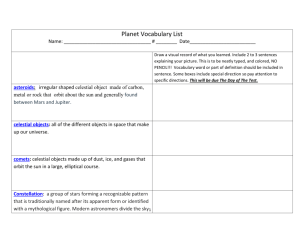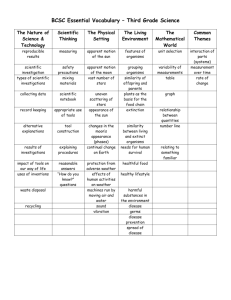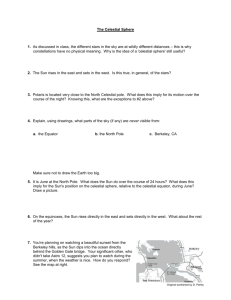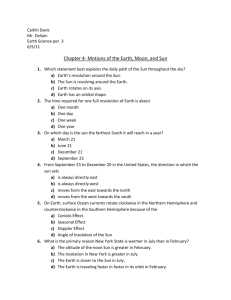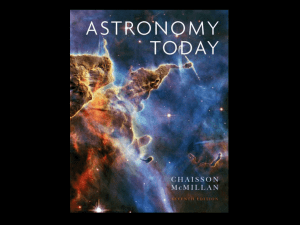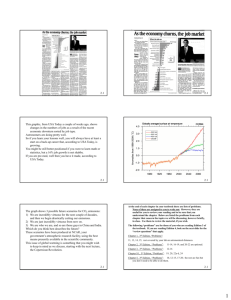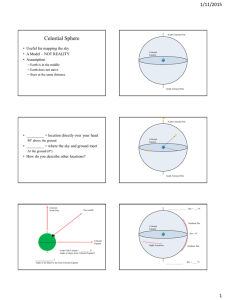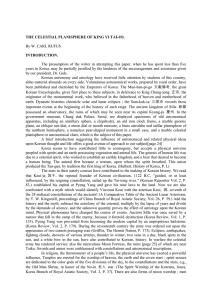Observing the Sky - University of Northern Iowa
advertisement
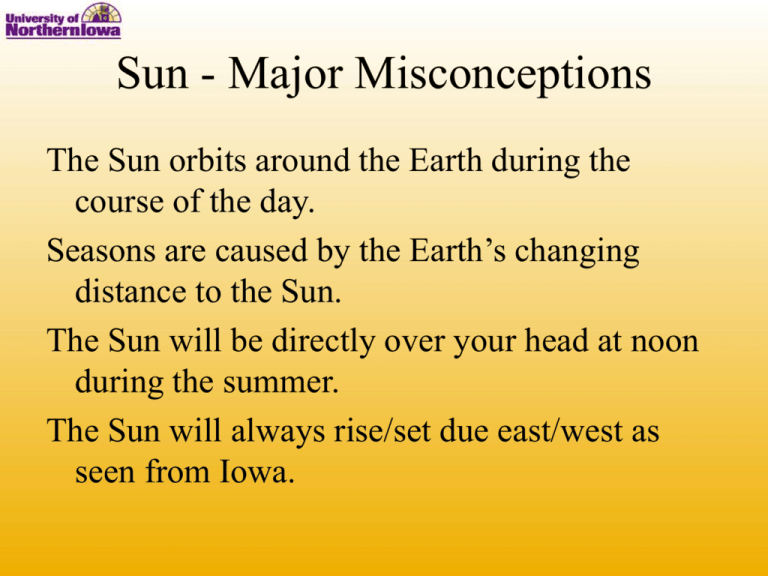
Sun - Major Misconceptions The Sun orbits around the Earth during the course of the day. Seasons are caused by the Earth’s changing distance to the Sun. The Sun will be directly over your head at noon during the summer. The Sun will always rise/set due east/west as seen from Iowa. The Sun • “Motion” vs Reality – Sun’s daily “motion” → OUR MOTION • We see the Sun appear to rise, set – Sun’s yearly “motion” → OUR MOTION • We see the Sun’s position relative to the stars change • We see the Sun’s position relative to the horizon change • Important factors – The Earth is tilted relative to its orbit – Your location & date determines where/when you see the Sun Located over the Earth’s equator – Equinox (Vernal and Autumnal) At the most northerly point – Summer Solstice Above the “Tropic of Cancer”, Latitude = 23.5º N. At the most southerly point – Winter Solstice Above the “Tropic of Capricorn”, Latitude = 23.5º S. WHAT??? On December 21 the Sun is located above the Tropic of Capricorn? Why not the “Tropic of Sagittarius”? Astrology! • Pseudoscience – 12 signs of the zodiac – People who waste a lot of time/money – People who earn a lot of money! • Originates with ancient Babylonians, Egyptians – Around 2000 BCE – Since then things have changed… Let’s check out some animations…. Precession • • • • Alters our alignment to the sky/stars Alters our alignment to the Sun Alters calendars (until around 1600) Demonstrate “wrong sign” Sky View Café Observing the Sun • SAFETY • Avoid magnification if possible – Projection is best • Avoid overheating equipment – Open ended telescopes (simple reflectors) – Light blocking filters • Use only REAL SOLAR FILTERS – Block 99.999% of sunlight What’s to see? • Sun spots (well, maybe) – Check before hand • Solar Cycle • Solar Activity – Aurora – Flares Lunar Misconceptions • The Moon does not rotate because we see only one side of it. • The dark side of the Moon always faces away from the Earth. • The Moon causes seasons. • The Moon is only visible at night. • Phases are caused by the Earth’s shadow. Phases • Entire cycle takes 29.53 days • Approximately 1 week between major phases – New, First Qtr, Full, Third/Last Qtr • Time scale – Earth rotates faster (~24 hours versus ~30 days) – Moon slowly moves relative to the stars – Daily change in position notable Is this good? Physical Model • • • • 3-D Interactive Pace of motion (Earth and Moon) Alignments – Earth-Sun = Time of day – Earth-Moon-Sun = Phase of Moon • Light variation Eclipses • Lunar • Solar – – – – – – – – – – – – Full Moon Visible to many Longer duration Moon darkened Not dangerous Types • Total (all umbral) • Partial (part umbral) • Penumbral (lame!) New Moon Visible to few Shorter duration Sun blocked Dangerous Types • • • • Total Annular Partial Hybrid Movie St Louis Movie Stars • Constellations – 88 Regions in the sky – NOT JUST THE STICK FIGURES! – Cultural origins • Asterisms – Useful tool – Informal – not official! Summer Triangle Keystone Northern Cross Fish hook Teapot 4 C’s M/W Great Square of Pegasus Kids Beehive Winter Triangle Heavenly “G” 7 Sisters Pleiades Subaru Belt of Orion Sword of Orion Little Dipper Big Dipper Kite, Ice cream Sickle Measuring Stars • Magnitude Scale 1 – brightest 2 – not so bright 3 – even fainter 4 – fainter still Etc. • Apparent Magnitude Scale (m) Examples Star Sun Sirius Vega Polaris Arcturus m -26.4 -1.4 0 2.0 -0.1 Celestial Sphere • A Model – NOT REALITY • Tool for mapping • Define Coordinate system – Right Ascension, Declination – Celestial Equator, Celestial Pole – NO DEPTH/DISTANCE North Celestial Pole Northern Dec Celestial Equator Dec = 0º RA Southern Dec South Celestial Pole North Celestial Pole Ecliptic Celestial Equator South Celestial Pole IT IS ONLY A MODEL! NOT REALITY! • • • • • Sun doesn’t orbit the Earth – Earth orbits! Orbits are not circles! Stars are not on a giant sphere! Distances are much greater! Motions (real and apparent) = units of time – Apparent motion of stars = 23:56 = Sidereal day – Apparent motion of Sun = 24 hours = Solar day – Rotation of the Earth = ? Sidereal Day (23:56) Apparent motion of the stars • Generally “east” to “west” • Except for circumpolar stars • Time for some more animation…
